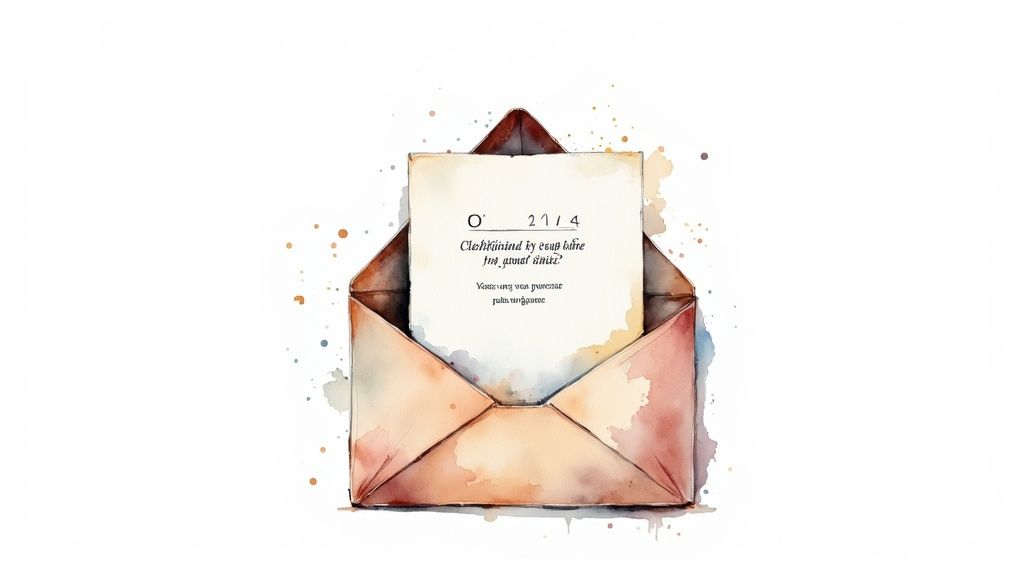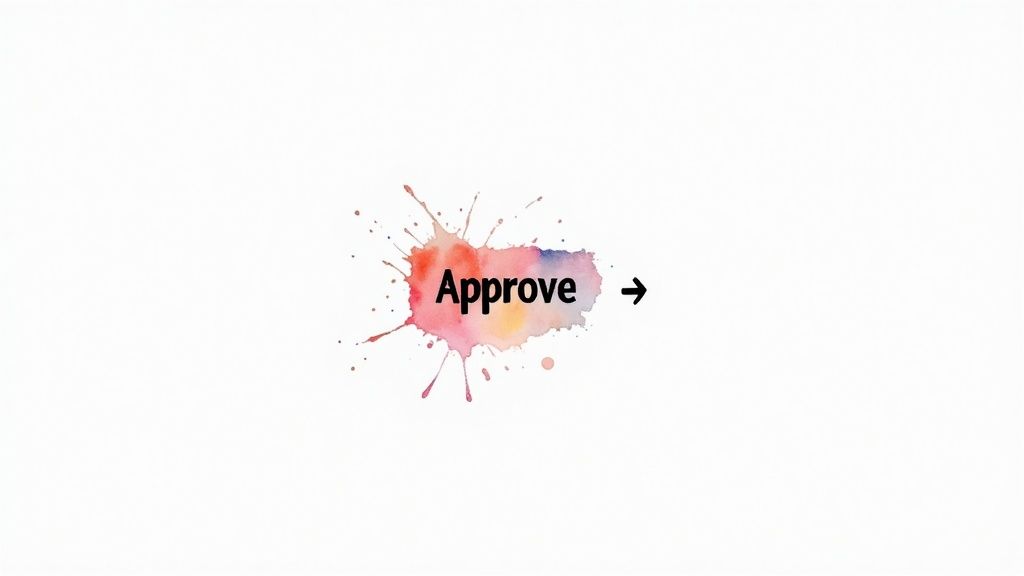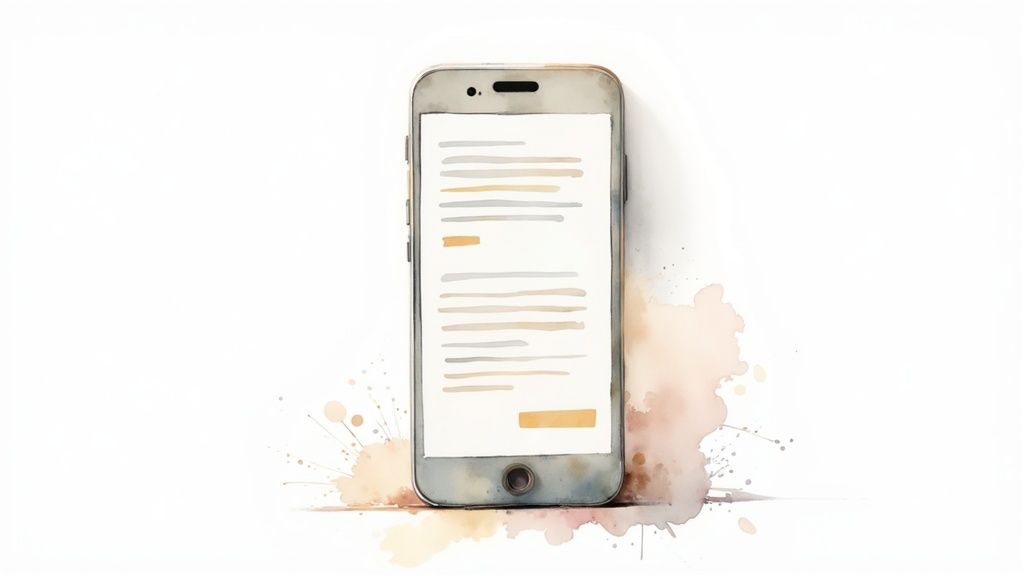Email Communication Tips: Best Practices to Master Your Inbox
Max
In our increasingly distributed, remote-first world, email remains the backbone of professional correspondence. Yet, a poorly managed inbox often leads to missed opportunities, critical miscommunications, and unnecessary stress. The difference between a thriving career and a stagnant one can hinge on mastering this fundamental skill. A disorganized approach creates digital friction, while a strategic one builds momentum and fosters clarity.
This guide moves beyond generic advice to provide a definitive roundup of the best practices for email communication. We will deliver actionable, nuanced strategies tailored for the modern workplace, especially within a remote context. Whether you’re coordinating with a global team, managing client relationships, or seeking your next opportunity, these principles will transform your email from a source of anxiety into a powerful tool for productivity and professional growth.
You will learn how to:
- Craft emails that get opened, understood, and acted upon.
- Structure messages for maximum clarity and impact.
- Maintain security and professionalism in every interaction.
Ultimately, mastering your inbox is a critical step toward enhancing your professional effectiveness. Let’s dive into the specific techniques that will help you communicate with purpose and precision.
1. Write Clear and Specific Subject Lines
Your email subject line is the gatekeeper of your message. It’s the first thing a recipient sees and heavily influences whether they open, prioritize, or ignore your communication. An effective subject line acts as a summary, conveying the email’s purpose and any required action at a glance. This is a foundational best practice for email communication, as it respects the recipient’s time and sets clear expectations from the start.

Think of your subject line as a headline for your email. It needs to be concise, informative, and immediately understandable, especially on mobile devices where space is limited. Aim for 50 characters or fewer to avoid your message being truncated.
How to Implement This Practice
To make your subject lines work for you, focus on clarity and specificity. Use keywords that signal the email’s intent and urgency.
- For action-oriented emails: Start with a verb.
- Bad: Budget
- Good: Action Required: Review Q4 Budget by EOD Friday
- For informational updates: State the key takeaway.
- Bad: Meeting update
- Good: Meeting Rescheduled: Project Kickoff Now at 3 PM Today
- For inquiries: Be direct and mention the topic.
- Bad: Question
- Good: Quick Question About the Johnson Project Timeline
Actionable Tips for Better Subject Lines
- Use Prefixes: Employ bracketed tags like
[ACTION REQUIRED],[FYI], or[URGENT]to help recipients categorize and prioritize your email instantly. - Include Deadlines: If there’s a due date, put it directly in the subject line (e.g., “Submit Timesheet by 5 PM, June 20”). This creates a clear sense of urgency.
- Avoid Vague Language: Words like “Update,” “Info,” or “Hello” are too generic and often get overlooked in a crowded inbox.
- Test on Mobile: Before hitting send, consider how your subject line will appear on a phone. Does it get cut off? Is the most important information visible?
For those in sales or marketing roles where engagement is paramount, there are many more advanced techniques to consider. For more in-depth advice on optimizing this crucial element, delve into these strategies for crafting effective email subject lines to help boost opens and conversions.
2. Use Professional Email Structure and Formatting
Beyond the subject line, the internal structure of your email determines its readability and professional impact. A well-structured email follows a logical format that guides the recipient through your message, making the information easy to scan, digest, and act upon. This includes a proper salutation, an organized body, a clear call-to-action, and a professional signature. Adhering to this best practice for email communication shows respect for the recipient’s time and significantly enhances comprehension.

Think of your email’s body like a mini-report. It needs a clear beginning (greeting), middle (main points), and end (closing and signature). This predictable format ensures your message is not just received but understood, which is critical in professional settings like investment banks, law firms, and consulting companies where clarity is non-negotiable.
How to Implement This Practice
Adopt a consistent template for your communications. Start with a professional salutation, present your main point early, use subsequent paragraphs for supporting details, and conclude with a clear next step.
- Greeting: Use a formal salutation like “Dear [Name],” or a less formal but still professional “Hi [Name],” depending on your relationship with the recipient.
- Body: Break your message into short, focused paragraphs. Use single spacing within paragraphs and double spacing between them to create visual separation.
- Closing: Conclude with a professional closing such as “Best regards,” or “Sincerely,” followed by your signature.
To visualize how these best practices translate into real-world applications, exploring various professional email examples and templates can provide a solid foundation for your own communications.
Actionable Tips for Better Email Structure
- Limit Paragraph Length: Keep paragraphs to a maximum of 3-4 sentences to improve readability, especially on mobile devices.
- Use Formatting Sparingly: Use bolding, italics, or bullet points to highlight key information, dates, or action items. Overusing them can make the email look cluttered.
- Create a Professional Signature: Ensure your signature includes your full name, title, company, and contact information. This adds a layer of professionalism and makes it easy for others to reach you.
- Use Professional Email Addresses: Your email address itself is part of your communication. Avoid nicknames or unprofessional handles; stick to a format like
[email protected].
In a remote work environment, where email often replaces face-to-face interaction, structured communication is even more crucial. It acts as a key component of effective digital collaboration. You can learn more about the other essential remote collaboration tools that complement strong email practices.
3. Practice Email Brevity and Conciseness
In today’s fast-paced professional environment, everyone’s inbox is overflowing. Practicing brevity and conciseness respects the recipient’s time and increases the likelihood that your message will be read, understood, and acted upon. This approach, championed by leaders like Jeff Bezos at Amazon, focuses on delivering essential information clearly and efficiently without sacrificing necessary details or professionalism. It’s a critical component of effective email communication.

The goal is to communicate your core message in the fewest words possible. Think of military communication, where precision and speed are paramount; every word serves a direct purpose. Adopting this mindset helps you eliminate fluff and get straight to the point, making your emails more impactful.
How to Implement This Practice
To write more concisely, focus on trimming unnecessary words and structuring your message for quick comprehension. Use short paragraphs, bullet points, and bold text to highlight key information, making it scannable.
- For project updates: Front-load the most important information.
- Bad: I wanted to follow up on our conversation from last week about the Q3 marketing campaign. After reviewing the materials, I have some thoughts on the proposed timeline and would like to suggest a few adjustments based on my findings.
- Good: Here are my proposed adjustments to the Q3 marketing campaign timeline:
- Launch date moved to July 15
- Ad copy finalized by July 1
- Please review and provide feedback by EOD tomorrow.
- For internal requests: State your need directly.
- Bad: I hope you are having a great week. I was wondering if you might have a moment to send over the latest sales report when you get a chance.
- Good: Could you please send me the Q2 Sales Report by 3 PM today?
Actionable Tips for Better Brevity
- Use Active Voice: It’s more direct and uses fewer words. “The team completed the project” is better than “The project was completed by the team.”
- Eliminate Filler Phrases: Cut words and phrases like “I think that,” “just,” “in order to,” and “I wanted to reach out.” They add length without adding value.
- Leverage Lists: Use bulleted or numbered lists to break down complex information, making it easier to digest quickly.
- Read Aloud: Before sending, read your email out loud. This helps you catch awkward phrasing, run-on sentences, and unnecessary words.
This focus on brevity is one of the foundational best practices for email communication that can significantly improve your professional interactions. For a deeper look into structuring effective messages, particularly in a business context, consider exploring how to write concise business communications.
4. Master Professional Email Tone and Language
The tone of your email communicates attitude and emotion through word choice, sentence structure, and overall approach. Since non-verbal cues like body language and voice inflection are absent, your words must do all the work. A professional tone strikes a careful balance between being friendly and authoritative, adapting to the audience, context, and company culture. Mastering this is a key best practice for email communication that builds relationships while maintaining respect and credibility.

Without the right tone, a simple request can sound like a demand, or constructive feedback can feel like an attack. This is especially critical in remote work environments, where email is often the primary mode of interaction. Getting the tone right prevents misunderstandings and fosters a more collaborative and positive virtual workplace.
How to Implement This Practice
The goal is to be clear, respectful, and appropriate for the situation. This means consciously choosing your words to convey the intended meaning and emotion.
- For diplomatic feedback: Frame suggestions constructively.
- Bad: Your idea won’t work.
- Good: Thank you for sharing that. I’d like to suggest an alternative approach that might address the budget constraints.
- For customer service: Show empathy and provide a solution.
- Bad: We can’t do that.
- Good: I understand your concern, and I apologize for the inconvenience. Here is what we can do to help resolve this.
- For international communication: Adjust your formality.
- Bad: Hey team, need this ASAP. (Too informal for some cultures)
- Good: Dear Team, Could you please provide the report by the end of the day? Thank you.
Actionable Tips for Better Email Tone
- Use Positive Framing: Instead of focusing on limitations (“We can’t ship until Friday”), highlight the solution (“We can confirm your order will ship this Friday”).
- Choose ‘We’ Over ‘You’: When discussing problems, using “we” fosters a sense of shared responsibility (e.g., “How can we solve this?”) instead of placing blame (“What are you going to do about this?”).
- Draft and Review: If you feel emotional, write a draft but wait to send it. Review it later with a clear head to ensure the tone is professional.
- Mirror the Recipient: Pay attention to the formality, greeting, and sign-off of the person you’re emailing and mirror it to build rapport.
Mastering your tone and language in emails often stems from strong fundamental writing abilities. For broader guidance, explore expert tips to improve your writing skills.
5. Implement Strategic Email Timing and Frequency
The impact of your email isn’t just about what you say; it’s also about when you say it. Strategic timing and frequency involve sending messages when recipients are most likely to engage and managing the volume of communication to avoid inbox fatigue. This practice respects the recipient’s workflow, considers different time zones, and ultimately increases the chances of a positive and timely response, making it one of the most crucial best practices for email communication.
When an email lands in a crowded inbox on a Monday morning or late on a Friday afternoon, it’s easily buried or ignored. By contrast, a well-timed message arrives when the recipient has the mental bandwidth to address it thoughtfully. This is especially critical for global and remote teams where work hours are not uniform.
How to Implement This Practice
To leverage strategic timing, you must think like your recipient. Consider their typical workday, industry norms, and location. Scheduling tools are invaluable for ensuring your message arrives at the optimal moment, not just when it’s convenient for you to send it.
- For B2B communications: Research suggests peak engagement occurs mid-week.
- Bad: Sending a critical project proposal at 4:45 PM on a Friday.
- Good: Scheduling the proposal to send at 10:30 AM on Tuesday or Wednesday.
- For internal updates: Avoid overwhelming colleagues. Bundle non-urgent information into a single digest.
- Bad: Sending five separate “FYI” emails throughout the day.
- Good: Sending one “Daily Team Update” email summarizing all key points.
- For follow-ups: Give the recipient adequate time to respond before nudging them.
- Bad: Following up two hours after the initial email.
- Good: Sending a polite follow-up 48-72 hours later.
Actionable Tips for Better Timing and Frequency
- Use Scheduling Tools: Platforms like Gmail and Outlook have built-in “Send Later” functions. Use them to schedule emails for optimal delivery times across different time zones.
- Mind the Calendar: Be aware of regional, cultural, and religious holidays. Sending a request to someone on their public holiday is unlikely to get a fast response.
- Set Frequency Expectations: If you manage a newsletter or regular updates, tell subscribers how often they can expect to hear from you to build trust.
- Avoid Peak “Ignore” Times: Steer clear of Monday mornings when people are catching up and Friday afternoons when they are winding down for the weekend.
Mastering email timing is a key skill, particularly in a distributed workforce. For a deeper understanding of how to coordinate across different locations, explore these best practices for remote teams.
6. Ensure Mobile-Friendly Email Design
With a significant majority of emails now being opened on mobile devices, optimizing for smaller screens is no longer optional; it’s essential. A mobile-friendly email design ensures your message is readable, professional, and actionable, regardless of how the recipient views it. This practice involves using responsive layouts, touch-friendly navigation, and concise content that delivers its point without requiring endless scrolling or pinching and zooming. Adhering to this is a key best practice for email communication that guarantees a positive user experience.
A non-optimized email can appear broken, be difficult to read, and cause links or buttons to be nearly impossible to tap. This frustration often leads recipients to delete the message without engaging, damaging your credibility and reducing the effectiveness of your communication. Think of brands like Spotify or Airbnb; their emails are clean, use a single-column layout, and feature large, tappable buttons, making interaction seamless on any device.
How to Implement This Practice
To make your emails mobile-friendly, prioritize simplicity and readability. A single-column layout is the gold standard, as it stacks content vertically and eliminates the need for horizontal scrolling. Use a large, legible font (at least 14-16px for body text) and ensure there is ample white space to prevent the design from feeling cluttered on a small screen.
- For marketing newsletters: Use a single-column template with large images and clear calls-to-action (CTAs).
- Bad: A multi-column layout with tiny, text-based links.
- Good: Spotify’s clean, single-column newsletter with a large, central “Listen Now” button.
- For transactional emails: Keep it focused and highlight the most critical information at the top.
- Bad: A dense paragraph detailing a purchase confirmation.
- Good: Airbnb’s booking confirmation with key details (dates, location) at the top, followed by a clear, tappable button.
Actionable Tips for Better Mobile Design
- Keep Subject Lines Short: Aim for under 30-40 characters to ensure the full subject is visible in mobile preview panes.
- Use Bullet Points: Break up long paragraphs with bullet points or numbered lists for easy scanning.
- Make Buttons Tappable: Ensure buttons and links have a minimum height of 44px to be easily tapped with a finger.
- Prioritize the Top: Place the most important information or call-to-action within the first few lines, as this is what’s visible without scrolling.
- Test Before Sending: Use email testing tools or simply send a test to your own mobile devices (both iOS and Android) to see how it renders.
This is especially crucial for remote workers who often switch between desktops and mobile devices throughout the day. Ensuring a consistent experience across platforms is part of a productive digital workspace. For more ideas on optimizing your digital environment, explore this guide on creating an effective remote work setup.
7. Use Clear Calls-to-Action (CTAs)
A common reason professional emails fail is ambiguity. The recipient reads your message but is unsure what you want them to do next. A strong call-to-action (CTA) eliminates this confusion by explicitly guiding the reader toward the desired outcome. This is one of the most critical best practices for email communication because it transforms a passive message into an actionable task, ensuring progress and accountability.
Your CTA is the “what next” of your email. It should be specific, action-oriented, and easy to find, leaving no room for interpretation. By clearly stating what action is required, by when, and how, you respect the recipient’s time and significantly increase the likelihood of getting the response you need.
How to Implement This Practice
To make your CTAs effective, use direct, action-oriented language. The goal is to make it incredibly simple for your recipient to understand and complete the task.
- For approvals: Clearly state what needs approval and the deadline.
- Bad: Let me know what you think of the proposal.
- Good: Please review the attached proposal and reply with your approval by Thursday, March 15.
- For scheduling: Provide a direct link or clear instructions.
- Bad: When are you free to meet?
- Good: Click here to confirm your attendance for the Monday 2 PM meeting.
- For submissions: Specify the task, link, and deadline.
- Bad: Expense reports are due soon.
- Good: Submit your expense report using this link by end of business Friday.
Actionable Tips for Better CTAs
- Start with Action Verbs: Begin your CTA with words like “Review,” “Submit,” “Confirm,” “Schedule,” or “Approve” to signal a required action immediately.
- Highlight Your CTA: Use bold text, a separate line, or a bullet point to make the call-to-action stand out from the rest of the email body.
- Include Deadlines: Always add a specific due date and time. This creates a natural sense of urgency and helps the recipient prioritize their tasks.
- Provide Alternatives: When possible, offer a secondary option. For example, “Reply ‘YES’ to confirm, or call me at 555-1234 to discuss alternatives.”
- Strategic Placement: For important requests, state the primary CTA near the beginning of the email and briefly repeat it at the end to reinforce the message.
8. Maintain Email Security and Privacy Standards
In our digital-first world, email is often a conduit for sensitive information, making security and privacy paramount. Maintaining high standards in this area involves protecting confidential data from unauthorized access, preventing costly data breaches, and adhering to legal regulations like GDPR and HIPAA. This is a critical best practice for email communication, as a single mistake can have significant legal, financial, and reputational consequences for you and your organization.
Prioritizing email security means treating every message with a level of caution. It’s not just about what you send, but also about protecting your inbox from external threats like phishing, malware, and social engineering attacks. A secure email practice is a proactive defense that safeguards professional and personal integrity.
How to Implement This Practice
Start by treating sensitive data with the respect it deserves. Never assume standard email is a secure channel for confidential information. Instead, implement clear protocols for handling anything that shouldn’t be public knowledge, from client details to internal financial reports.
- For handling confidential files: Use secure, encrypted file-sharing services or company-approved secure email portals instead of attaching them directly.
- Bad: Attaching a spreadsheet with employee Social Security numbers to a standard email.
- Good: Sending a secure link from an encrypted portal for the recipient to download the spreadsheet after verifying their identity.
- For mass communications: Protect the privacy of your recipients by using the Blind Carbon Copy (BCC) field.
- Bad: Placing a long list of external client emails in the “To” or “CC” field, exposing everyone’s contact information.
- Good: Placing your own email in the “To” field and all other recipients in the “BCC” field.
- For all communications: Always double-check the recipient’s email address before clicking send, especially when the content is sensitive.
Actionable Tips for Better Email Security
- Never Email High-Risk Data: Avoid sending passwords, credit card numbers, Social Security numbers, or other highly sensitive personal data through standard email.
- Use Encryption: For any communication containing sensitive information, use end-to-end email encryption tools to ensure only the intended recipient can read it.
- Enable Two-Factor Authentication (2FA): Add an extra layer of security to your email account to prevent unauthorized access even if your password is compromised.
- Be Skeptical of Incoming Mail: Learn to spot phishing attempts. Look for suspicious links, urgent requests for personal information, and poor grammar. When in doubt, do not click.
These practices are especially vital in a distributed work environment where company data is accessed from various networks. For a deeper understanding of safeguarding information while working from anywhere, explore these remote work security best practices to keep your communications secure.
Best Practices Comparison Matrix for Email Communication
| Email Best Practice | Implementation Complexity 🔄 | Resource Requirements ⚡ | Expected Outcomes 📊 | Ideal Use Cases 💡 | Key Advantages ⭐ |
|---|---|---|---|---|---|
| Write Clear and Specific Subject Lines | Low | Minimal | ↑ Open rates by ~47% | Any email needing prompt attention | Increases open rates, improves prioritization, saves time |
| Use Professional Email Structure and Formatting | Medium | Moderate | ↑ Comprehension and response rates | Formal, client-facing, and brand-sensitive emails | Projects professionalism, reduces misunderstandings |
| Practice Email Brevity and Conciseness | Medium | Low to Moderate | ↑ Readability and faster responses | Routine internal communications, status updates | Respects recipients’ time, reduces cognitive load |
| Master Professional Email Tone and Language | Medium to High | Moderate to High | ↑ Relationship building and cooperation | Sensitive, cross-cultural, or leadership communications | Builds trust, reduces conflict, enhances reputation |
| Implement Strategic Email Timing and Frequency | Medium | Moderate (analytics needed) | ↑ Open rates by up to 23%, better engagement | Marketing, sales, or high-volume communication contexts | Avoids email fatigue, maximizes business impact |
| Ensure Mobile-Friendly Email Design | Medium to High | Moderate to High | ↑ Engagement, click-through rates | All emails given majority mobile access | Future-proofs emails, enhances UX across devices |
| Use Clear Calls-to-Action (CTAs) | Low to Medium | Low to Moderate | ↑ Response rates by up to 371% | Action-driven communications, project requests | Speeds up processes, clarifies expectations |
| Maintain Email Security and Privacy Standards | High | High | Prevents breaches, maintains compliance | Sensitive data, regulated industries | Protects data, reduces legal risks, maintains trust |
Turning Email Best Practices into Lasting Habits
We’ve explored a comprehensive set of strategies, from crafting clear, specific subject lines to maintaining rigorous email security standards. Each of these principles serves a singular purpose: to transform your digital correspondence from a routine task into a powerful tool for professional advancement. Mastering these best practices for email communication is not about memorizing a static list of rules; it’s about fundamentally shifting your approach to how you interact in a digital-first world.
The journey from knowledge to habit is an incremental one. Rather than attempting to overhaul your entire email routine overnight, which can be overwhelming, focus on a targeted, phased implementation. This strategic approach ensures sustainable change and prevents you from reverting to old, less effective habits under pressure.
Your Action Plan for Implementation
Start by selecting just one or two practices that resonate most with your current challenges. Perhaps your team struggles with ambiguous requests, or you’ve noticed your emails don’t get prompt replies.
- Week 1-2: Focus on Clarity. Dedicate the next two weeks to perfecting your subject lines and calls-to-action (CTAs). Before hitting “send” on any email, ask yourself: “Is the purpose of this email immediately clear from the subject?” and “Is what I need from the recipient explicitly stated?”
- Week 3-4: Refine Your Structure and Tone. Shift your attention to brevity and professional formatting. Challenge yourself to cut every email’s length by 20% without losing its core message. Simultaneously, pay close attention to your tone, ensuring it strikes the right balance between professional and approachable, especially in a remote context.
- Week 5-6: Master Timing and Mobile Experience. Begin implementing strategic timing for your emails, considering your recipient’s time zone and workload. During this period, make it a habit to check how your emails render on a mobile device, guaranteeing they are easy to read and act upon from anywhere.
By focusing on these areas sequentially, you allow each new skill to become second nature. This methodical integration builds a strong foundation, making it easier to adopt the remaining practices, such as advanced security measures and consistent professional formatting, into your daily workflow.
The cumulative impact of these habits is profound. For individuals, it means greater efficiency, fewer misunderstandings, and a stronger professional reputation. For remote job seekers and tech professionals, demonstrating this level of polished communication can be a significant differentiator in a competitive market. For companies and HR leaders, embedding these best practices for email communication into your culture fosters a more productive, respectful, and secure remote work environment. Ultimately, treating every email as a meaningful interaction is an investment in your clarity, your relationships, and your career.
Ready to apply your polished communication skills in a role that values clarity and efficiency? Visit Remote First Jobs to explore opportunities with leading companies that prioritize effective remote collaboration. Find your next great career move at Remote First Jobs and put these best practices to work.


